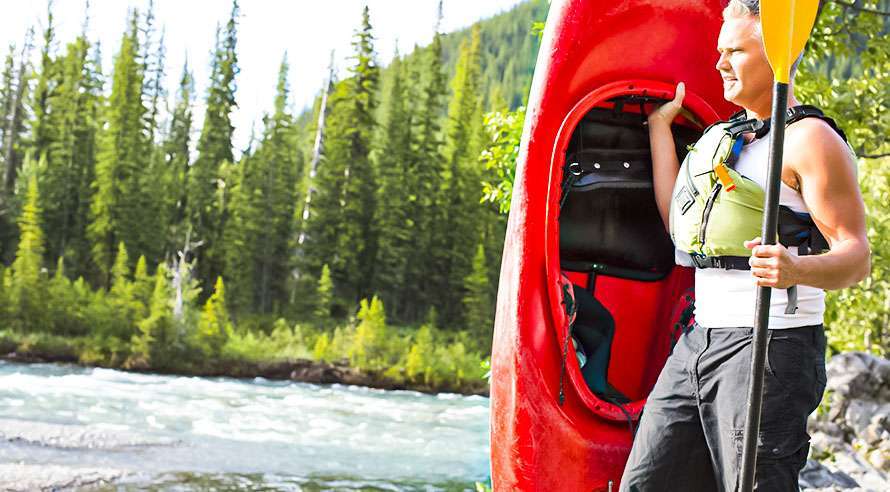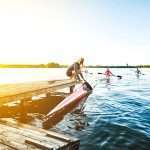If you are like most paddlers, your surfing probably has room for improvement. How often do you fall off a wave without a nice extended ride? Exceptional surfing ability is big fun and is a prerequisite to advanced moves. These tips will help you get longer, more predictable surfs.
Where to Aim to Get the Ride:
Your target is small! Many paddlers look at the entire wave as their target, when in reality precision within a few inches is necessary. A common problem leaving the eddy is paddling too hard. Without precise aim, you’ll run up on the back of the oncoming water. Then your momentum slides you back and off the wave. It is better to ferry out onto the wave, so you don’t have any downstream momentum to counteract. Look for small feeder waves to help your move.
Stroke Selection:
Stroke selection and placement is important for maintaining control as you start a ferry or surf. The last stroke you do as you leave the eddy is especially important. Learn to do forward sweeps, stern draws, rudders, side slipping draws, and no correction strokes at all. You probably have one stroke system you use all the time…but hitting the small exit target can demand different strokes. Practice a full repertoire.
1. Forward sweep, stern draw
It is the end of the forward sweep, the stern draw, that corrects the angle of your boat. This uses current forces on the blade to correct your angle (but it is not quite as strong as a rudder). The best effect is reached when the blade is placed along the line of the current flow, in between a full forward sweep and a stern draw.
2. No Correction
If the angle you’ve chosen is just right, you can continue to alternate forward strokes as you cross the current in your ferry.
3. Rudder
Given enough speed and a conservative angle, a rudder on the eddyline side of your boat will control your angle. If you don’t have enough speed, or the right positioning, a rudder has a hard time working against the swirls of the eddy line. Many paddlers rely on this stroke, even when it is not the best option for hitting the target and maintaining angle.
4. Sideslipping draws
These strokes can fine tune your position, keeping your boat parallel as it moves sideways onto a wave. The sideslip looks easy, but it’s not! Practice on flatwater. Get up some speed then place the stroke by your hip to move the boat sideways.
Out on the Wave: Pure Rudders and Wedging Rudders
Once out on the wave, many paddlers try to correct with braking rudders, then wonder why they miss the surf. A rudder wedged in alongside your hip drags the boat backward. These braking rudders work well on steep waves. But a wedged-in rudder is detrimental on small waves, which require more subtle correction. This is usually the case on approaches to big waves. The shoulders of these waves are smaller, requiring finesse. As a result, to have the best rides you need to use streamlined, no-drag rudders to get out to the wave. Then use braking rudders only if you need to back up. If you only need to turn, you use pure rudders combined with lower body power.
If you want to surf, memorize this position. It comes at the end of the forward sweep or stern draw. Now examine the position of the blade. Rotate your torso way around, drop your elbow down, and extend your front arm out over the water. The critical element is keeping the paddle shaft parallel to the boat, with the blade in the water at the correct angle. Keeping the top hand above eye level puts the blade deep in the water and at the correct angle to have the strongest effect. The taller the wave, the higher your front hand will be to keep the back blade in the water.
Try this Drill: Surfing Flatwater
Get some speed and then take your blade out of the water. As your boat veers off course, poise a stern draw ready to make a correction. Use the stern draw to correct the veer, and leave the blade in the water. Keep your front hand out over the water. Straighten and bend only your back arm to rudder and draw the boat as it glides forward. The result should be a slight zigzag. If your boat speed dies, check the angle of your blade, and make sure your front hand remains out over the water. When your control hand is forward, relax your grip and let the shaft rotate as your back hand controls the blade angle.
Repeat the drill using only the rudder on alternating sides of the boat. If your speed dies immediately, check your rotation and blade angle. Many paddlers don’t know this precise, pure rudder. Instead, they have the blade flat or do an inadvertent braking stroke. Watch your blade until your muscles have developed a memory. Repeat the same drill watching a distant landmark. Control your bow, veering your bow one foot either direction as you glide toward your goal. Next, practice controlling the veer of your boat to within a few inches. Here’s a hint: For the most power on your rudders and stern draws, imagine that the stern of your boat is your tail. Instead of pulling on a stroke with your arms, try to wag your tail towards the blade. It sounds silly, but it works!
Surfing Subtleties
To develop more precision and power with your surfing, try stationary strokes. The more control you have from one side, the more options you have when surfing stronger, more complex waves. This is an especially useful technique on crowded waves with someone close to you on the wave.
Try this drill: Start on a small, six-inch wave. Drop the blade in, and change the angle subtly for more turning pressure. Then twist the blade to get pressure on the opposite face and turn the other direction. Work on making this motion subtle. Feel for the current on alternate faces of the blade. To do this, don’t pull on the shaft. Instead, twist the blade and change the orientation of the shaft to the current. When ruddering, the shaft is not quite parallel to the current. To draw, take the shaft past parallel to the current. Think of each correction rudder and draw as stopping the last turn, rather than starting a new one. This simple trick gets you thinking ahead, and allows smaller corrections. Practice all of these surf drills on small waves.
Last modified: March 14, 2022


